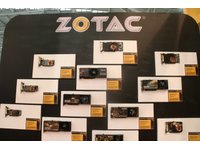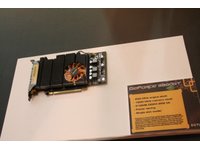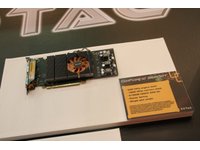Zotac Graphics Cards Pay for Themselves
Greentech, power optimization, saving the Earth, utilizing less resources--power saving features are an important feature to have these days, on any product.
We managed to catch up with Zotac, who told us that there's an increasing demand for graphics cards that utilize less energy but still provide good gaming performance.



Enter the Zotac 9600 GT and 9800 GT cards. Neither card utilizes a separate power feed, and rely solely on the PCI-e connection. According to Zotac, the 9600 GT and 9800 GT deliver up to 40-percent power savings when compared to other 9600 GT and 9800 GT products on the market. Zotac told us that it went with its own custom designed board utilizing components not on the original OEM standard build to deliver better longevity and better power utilization.
According to Zotac engineers, if one were to use the card for 2 hours a day, everyday of the year, they would save roughly $100. Most users tend to leave their computers on for much longer durations and some don't even turn off their systems. At these usage levels, users can expect even greater returns, with the cards paying for themselves quickly.
Of course, Zotac also showed off its full line of graphics cards, all the way up to its GTX 285 AMP edition.
We're definitely hoping that more manufacturers follow Zotac's lead in this space.
Get Tom's Hardware's best news and in-depth reviews, straight to your inbox.
-
Onus Very nice. These will go on my short list for future builds that don't absolutely require more graphics horsepower (they shouldn't).Reply
-
Onus ...well, they will when Newegg has them. All their Zotacs now are older ones with power connectors on them.Reply -
fudgeboy it would be so much better if it actually DID pay for itself.... oh well - back to work....Reply -
KyleSTL Numbers time:Reply
PCIe can supply 75W max. Let's say the 9800GT is consuming exactly that much. 40% (maximum quote power savings) of 75W is 30W savings.
30W * 2hours/day * 365days/year * 1kW/1000W = 21.9kW-hr ~= $2.20 (assuming $0.10/kW-hr)
I call B.S. Someone back me up on correct math, but 'paying for itself in power savings' is busted. -
siliconchampion @KyleSTLReply
What you would want to do is take 75 W and divide that by .6. this would give you the maximum power consumtion before the new power saving methods. This equals 125, so the difference would be 50 watts. (this difference represents a 40% savings from 125 watts to 75.)
Also, electricity rates are more along the average of $0.12 per kw/h.
So to correct you, the actual yearly savings amounts to a whopping $4.38.
Regardless, I'd like to see how Zotac did its math.
Also, if I am wrong, feel free to correct me. -
Maybe what they meant was, after you run the numbers and realize that you are only going to save a few dollars, you wont go out at buy one, thus saving you $100+. So the card really does pay for its self ;)Reply
-
830hobbes siliconchampion@KyleSTLWhat you would want to do is take 75 W and divide that by .6. this would give you the maximum power consumtion before the new power saving methods. This equals 125, so the difference would be 50 watts. (this difference represents a 40% savings from 125 watts to 75.)Also, electricity rates are more along the average of $0.12 per kw/h.So to correct you, the actual yearly savings amounts to a whopping $4.38.Regardless, I'd like to see how Zotac did its math.Also, if I am wrong, feel free to correct me.Reply
Maybe they mean that's what you'll save over the life of the computer... and assume you'll own your computer for 20-25 years...